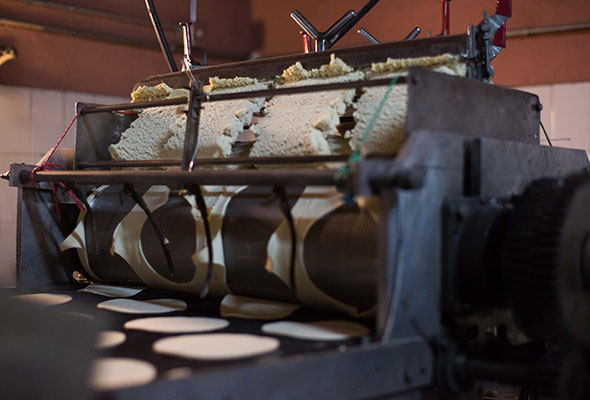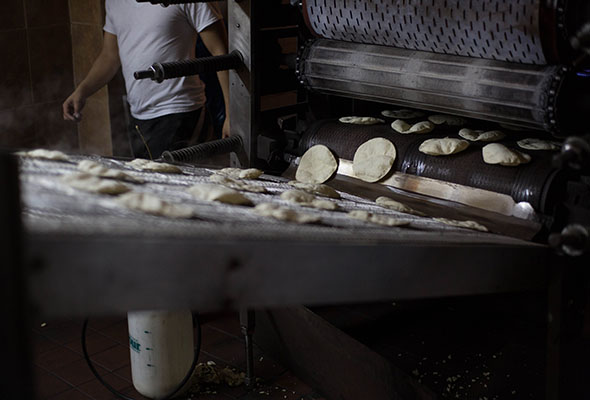Los Hermanos’ Tortillas Keep Bushwick’s Corazon Beating
By Amber Jamieson
Mexican pop music blasts out just loud enough to dim the rumbling of machines that will pump out 10,000 fresh tortillas this evening. Outside is a snowy 20 degrees, but inside this double garage in Bushwick, Brooklyn, the air is warm and smells of toasted corn.
It’s 5:30 p.m. on a weekday, the start of a shift for the employees of Los Hermanos Tortilleria, located next to the Jefferson St subway stop.
Three nights a week the workers mix Maseca-brand corn flour with hot water in a large industrial stand mixer and then feed the dough into a machine which flattens and cuts the dough into perfect circles and moves them onto a three foot-wide conveyor belt that slides the tortillas into the oven.

A machine at Los Hermanos tortilleria in Bushwick flattens the tortilla dough and cuts it into circles, before it goes into the grill. Photo: Amber Jamieson.
Los Hermanos owner and founder Marcelo Lazaro, 52, picks up a freshly cooked tortilla, which he judges to be undercooked. For the last 14 years, Lazaro has been making tortillas in this busy shop front, assisted by his wife and three eldest children: Aris, Jose and Tania. But the work can still be tricky and Lazaro heads over to the oven to turn it up.
“Cada momento tienes que cambiarlo, depende del peso (every moment you have to change it, depending on the weight),” said Lazaro, who moved from Puebla, Mexico, southeast of Mexico City, shortly before opening Los Hermanos.
Once the tortillas emerge, slightly toasted and bubbling, the conveyor belt zig-zags around to let them cool, before it spits out a stack of warm tortillas. The workers, all Mexicans, spin them to create a perfectly shaped stack, and then pop the tortillas into a plastic bag and neatly tie it shut.

Hundreds of freshly cooked tortillas roll off the conveyor belt at Bushwick’s Los Hermanos
tortilleria every few minutes, before they are stacked and packed into bags, ready for sale.
Each bag contains 28 tortillas and costs just $1 for retail customers. But nearly all are packed into boxes – 30 bags to a box – and sold to 40 local supermarkets, food shops and restaurants across the city for between $25 and 28.
“About four years ago, production was insane. We would have the whole place stacked,” said Tania Lazaro, 19, gesturing at the boxes of tortillas on the floor. Things have been quieter in recent years, thanks to a price war in the New York tortilla scene. Competitors in Bushwick and Flushing are charging just $20 for a box of tortillas.
Tania, who combines studying with working nights and weekends working in the small restaurant at the front of Los Hermanos, recently bought a stack of other local brand tortillas to compare them to Los Hermanos’. Good tortillas bubble when heated and don’t tear easily, and the cheaper tortillas missed on both counts, says Tania. She suspects competitors are keeping the price down by using cheaper, lower quality flour, but that impacts the product and affects the standard of Mexican tortillas available in New York City. “I tell my dad – regardless of how bad it is, I don’t want to change the quality,” she said.
Their tortillas have helped build a cult internet following for the tacos, quesadillas and tostadas being eaten in the restaurant, where business is growing even as the sale of tortillas diminishes.
The New York Times first wrote about the taqueria in 2006, noting its “top-notch tacos.” Chef Anthony Bourdain came in 2009 to eat tostadas and film a segment for his television show No Reservations, and Los Hermanos made the lists of NYC’s top taco joints in publications including New York Magazine, Gothamist, Time Out and Village Voice.
“In my opinion, it’s the best Mexican I’ve had for a long time,” said Amy Rinaldi, 27, an artist. She has lived in Bushwick for the last two years. but says she regularly travelled from other neighborhoods to eat at Los Hermanos for years before she moved to the area.
In 2006 the Lazaros ran just a tiny taco stall inside the factory, before setting up the no-nonsense restaurant – customers write their own orders out on notecards, there is no table service and it’s paper plates only – five years ago.
A Virgin Mary statue covered in colored fairy lights overlooks the grill and cash register, just to the left of a television that constantly blares Latin American soaps and a refrigerator stocked with Jarritos, a Mexican soda brand, and Mexican Coca-Cola. On the stainless steel countertop sits a cup of pens with a plastic knife taped to each pen, ready for customers to write out their orders. Jose Lazaro, one of Marcelo’s sons who works the front counter, estimates the unorthodox knife-and-pen arrangement saves the business $200 in lost pens annually.
The customers who pour in between the serving hours of noon and 10 p.m. fit the hipster stereotype – lots of guys in their 20s wearing small woolen fisherman beanies and 90s style re-issued Reeboks, talking about internet dating and the new band they’ve joined.
Cheap rents have made Bushwick a hot spot for young creatives in the last five years, with the neighborhood now full of art studios, an organic grocery store, two specialist coffee shops and a handful of new cocktail-meets-dive bars.
“I feel like everytime I’m in here it’s a different crowd,” said Rinaldi, who has an art studio nearby. She eats at Los Hermanos three times a week, usually either a tostada or a quesadilla.
Marcelo Lazaro sees it more simply. “Son blancos. Osea, Americanos (They’re white. Like, Americans),” he said, when asked who his customers were. He says the majority of Los Hermanos customers have always been white Americans.
Weekdays are more of a mix, mainly thanks to local Hispanic factory workers, who come for the meal-sized $2.50 chorizo tostadas. Hispanics make up 41% of Bushwick North’s population, according to 2010 census data. White non-Hispanics make up 10%. “On Saturday you will have one table full of Hispanics, but the rest are Caucasians,” said Tania Lazaro.
“Which is good because they love our food and it’s helping us out … but the area has changed a lot,” she said. She grew up in Bushwick, next to her parents’ tortilla factory, and speaks openly about how the neighborhood has changed in the last five years. She was not allowed to walk to the store around the corner by herself as a child because it was so dangerous.
Now, she says, she watches groups of young men and women walk home drunk at odd hours with no fear of being attacked. “Nine years ago you wouldn’t do that because it would be easy to wake up on the side of the street robbed,” she said.
The Mexican population is likelier to settle in the Bronx than Brooklyn these days, with just a 26% increase in the Mexican population in Brooklyn in the last decade, compared to a 102% jump in the Bronx. But it hasn’t been a complete Hispanic flight: of all the New York suburbs where Mexican-born immigrants settled between 2007-2011, Bushwick was third on the list. That meant over 10,000 new residents, making up nearly 6% of all Mexican immigrants to the city.
Martin Salles, 52, works in a local paper factory and lives just around the corner, after moving from his native Mexico. Every eight days he comes to Los Hermanos and buys three bags of tortillas – “Solo para mi (just for me),” said Salles. He lives alone. He never buys pre-made food being sold by Los Hermanos, just the tortillas, which he takes home and uses to cook tacos and quesadillas.
Before coming to New York, Marcelo Lazaro was a farmer. He no longer works in the countryside, but he says the tortillas and food he creates is the same simple way he has always eaten: toasted tortillas with freshly grilled meat, topped with lettuce, tomatoes, onion and a drizzling of queso fresco.
“No es comida fina, es que come el campesino (It’s not fine food, it’s what peasants eat),” he said.
Tags: Brooklyn, Bushwick, Los Hermanos Tortilleria, Mexican, tacos
Your Comments